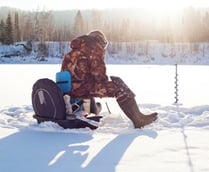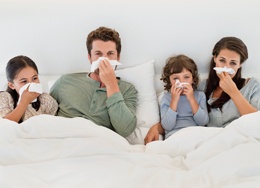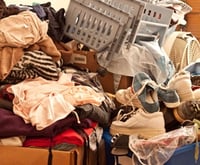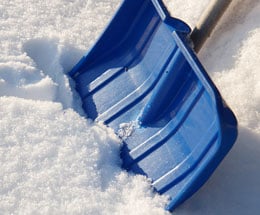
During the winter months, frozen lakes host a flurry of outdoor activities. Anglers, ice shanties, and recreational vehicles are a common scene.
While many enjoy winter activities on the ice, these activities can lead to serious injury if the proper precautions aren’t taken.
Before you head out on the ice this winter, check out these safety tips.
1. Share your fishing plans. It’s a good idea to share your plans with your family, friends, or neighbors. Let them know:
- The name of the lake you’ll be fishing on;
- The location of your fishing hot spot (i.e. north shore, south shore, etc.); and
- When you plan to arrive home.
If the fish are actively biting and you decide to stay out longer, notify them of your change in plans.
2. Bring a friend. When going ice fishing, never go alone. A friend can:
- Provide an extra set of hands;
- Help you stay focused on safety; and
- Alert authorities if something goes wrong.
3. Talk to the locals. They can provide information on ice thickness, water movement, and other information pertinent to the lake.
4. Follow these ice thickness guidelines. Remember, ice is never 100% safe. Ice thickness can change very quickly.
2″ or less – STAY OFF!
4″ – Ice fishing or other activities on foot
5″ – Snowmobile or ATV
8″ – 12″ – Car or small pickup
12″ – 15″ – Medium truck
5. Purchase a flotation suit. A flotation suit is the most important item you can buy. If you fall through the ice, a flotation suit will keep you warm and make it easier to escape the frigid water.
6. Carry a pair of ice picks/rescue claws. Keep a quality pair of ice picks with you at all times. If you fall through the ice, ice picks make it possible for you to climb out. Don’t skimp on this life saving device.
7. Carry a throw rope. A throw rope can be used to pull a fellow angler to safety.
8. Leave the lake before dark. Navigation at night can be treacherous. Without familiar visuals or a navigation device, you can become disorientated making it difficult to find your way off the ice.
9. Install proper ventilation. If your ice shanty is heated, make sure you have good ventilation. A poorly ventilated shanty can lead to carbon monoxide poisoning.
10. Bring a portable power bank battery charger. Cold temperatures can quickly drain your smartphone battery. A quality charger can save the day. I would recommend buying a high capacity charger. While they’re a bit more expensive, they can provide multiple charges, and can charge multiple phones at one time. To avoid permanent damage, turn your phone off in extremely cold temperatures.
11. Respect the ice auger. Ice augers are built to drill holes quickly and efficiently. Before operating it for the first time, read the owner’s manual. In addition, avoid wearing loose clothing or jewelry. When you are finished with the auger, store it in a safe place. Lastly, always maintain sharp blades to avoid injury while drilling.
12. Stay hydrated. Staying hydrated is very important. Dehydration can happen quickly in cold weather because your body is working hard to stay warm. Check out “8 Tips for Hydrating in Cold Weather.”
13. Layer up. Selecting the right number of layers is important. Beginners to winter activities tend to underdress, especially if it’s a sunny day. Choosing the right number of layers, based on temperature, can only be accomplished through trial and error. Before venturing out on the ice practice at home.
Check out our blog “Will your vehicle sink or swim if it falls through the ice?” This blog discusses how insurance will respond if your vehicle breaks through the ice.
SOURCE: West Bend, Scott Stueber on Jan 23, 2018 11:06:23 AM
 Whether at work, the grocery store, or school, it’s very common to hear sounds of the season. Unfortunately, I’m referring to sneezes, coughs, and sniffles.
Whether at work, the grocery store, or school, it’s very common to hear sounds of the season. Unfortunately, I’m referring to sneezes, coughs, and sniffles.
 Hoarding has not only become a popular topic for media coverage, it’s also a trending topic in the insurance industry. Because it’s more prevalent in our society today, Jenny Bischoff senior personal lines underwriter will explain the practice of hoarding and how it affects insurance coverage and claims.
Hoarding has not only become a popular topic for media coverage, it’s also a trending topic in the insurance industry. Because it’s more prevalent in our society today, Jenny Bischoff senior personal lines underwriter will explain the practice of hoarding and how it affects insurance coverage and claims. Let’s face it – winter presents many problems for homeowners. From cold temperatures that make heating systems work overtime, to snow and ice that clog driveways, gutters, and walkways, winter creates a wide range of challenges that can cost time and money. But that’s not all—winter can make it tough to maintain privacy as well. Thanks to winter’s short days and long nights, homeowners need well-lit homes during active evening hours. That’s why it’s important to have effective window treatments—blocking the view in from the outside.
Let’s face it – winter presents many problems for homeowners. From cold temperatures that make heating systems work overtime, to snow and ice that clog driveways, gutters, and walkways, winter creates a wide range of challenges that can cost time and money. But that’s not all—winter can make it tough to maintain privacy as well. Thanks to winter’s short days and long nights, homeowners need well-lit homes during active evening hours. That’s why it’s important to have effective window treatments—blocking the view in from the outside. Let it snow, let it snow, let it snow. Now what?
Let it snow, let it snow, let it snow. Now what? Currently, many of us are frantically buying and wrapping presents in time for Christmas. When Christmas morning arrives, our kids are filled with anticipation and excitement. That can all come to a screeching halt if you forgot to buy batteries.
Currently, many of us are frantically buying and wrapping presents in time for Christmas. When Christmas morning arrives, our kids are filled with anticipation and excitement. That can all come to a screeching halt if you forgot to buy batteries.